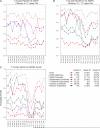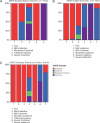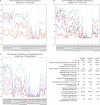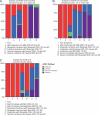Latent class subtyping of attention-deficit/hyperactivity disorder and comorbid conditions
- PMID: 18520958
- PMCID: PMC2774844
- DOI: 10.1097/CHI.0b013e318173f70b
Latent class subtyping of attention-deficit/hyperactivity disorder and comorbid conditions
Abstract
Objective: Genetic studies of attention-deficit/hyperactivity disorder (ADHD) generally use discrete DSM-IV subtypes to define diagnostic status. To improve correspondence between phenotypic variance and putative susceptibility genes, multivariate classification methods such as latent class analysis (LCA) have been proposed. The aim of this study was to perform LCA in a sample of 1,010 individuals from a nationwide recruitment of unilineal nuclear families with at least one child with ADHD and another child either affected or clearly unaffected.
Method: LCA models containing one through 10 classes were fitted to data derived from all DSM-IV symptoms for ADHD, oppositional defiant disorder, and conduct disorder (CD), as well as seven items that screen for anxiety and depression from the National Initiative for Children's Healthcare Quality Vanderbilt Assessment Scale for Parents.
Results: We replicated six to eight statistically significantly distinct clusters, similar to those described in other cross-cultural studies, mostly stable when comorbidities are included. For all age groups, anxiety and depression are strongly related to Inattentive and Combined types. Externalizing symptoms, especially CD, are strongly associated with the Combined type of ADHD. Oppositional defiant disorder symptoms in young children are associated with either conduct disorder or anxiety-related symptoms.
Conclusions: Methods such as LCA allow inclusion of information about comorbidities to be quantitatively incorporated into genetic studies. LCA also permits incorporation of milder but still impairing phenotypes than are allowed using the DSM-IV. Such methods may be essential for analyses of large multicenter datasets and relevant for future clinical classifications. This population-based ADHD classification may help resolve the contradictory results presented in molecular genetic studies.
Figures




References
-
- Acosta MT, Arcos-Burgos M, Muenke M. Attention deficit/hyperactivity disorder (ADHD): complex phenotype, simple genotype? Genet Med. 2004;1:1–15. - PubMed
-
- Barkley RA. A critique of current diagnostic criteria for attention deficit hyperactivity disorder: clinical and research implications. J Dev Behav Pediatr. 1990;11:343–352. - PubMed
-
- Brown RT, Freeman WS, Perrin JM, et al. Prevalence and assessment of attention-deficit/hyperactivity disorder in primary care settings. Pediatrics. 2001;107:U86–U96. - PubMed
-
- Castellanos FX, Sonuga-Barke EJS, Milham MP, Tannock R. Characterizing cognition in ADHD: beyond executive dysfunction. Trends Cogn Sci. 2006;10:117–123. - PubMed
-
- Lahey BB, Pelham WE, Loney J, Lee SS, Willcutt E. Instability of the DSM-IV subtypes of ADHD from preschool through elementary school. Arch Gen Psychiatry. 2005;62:896–902. - PubMed
Publication types
MeSH terms
Grants and funding
LinkOut - more resources
Full Text Sources
Medical
Research Materials

